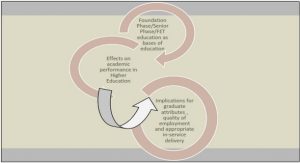Get Complete Project Material File(s) Now »
Acaricide
For centuries , tick control has been effected using chemical acaricides. Dipping in arsenical compounds was used against R.*microplus and R.*annulatus and worked well to eradicate these tick species from the USA in early 1900s. But resistance subsequently developed in the ticks. Organochlorine insecticides such as DDT and Benezenehexachloride, introduced later, eliminate ticks by preventing acetylcholine binding to its receptor, hence overRstimulating the sodium channels in neurons. However, resistance to organochlorine insecticides also developed in*R.*appendiculatus,* R.* microplus* and* R.* decoloratus in Australia and Africa. Furthermore, the residues persisted in the environment with potential but as yet unquantified implications for wildlife populations and human health. As a result of these factors their use has been discontinued. Organochlorines were replaced by organophosphates and organocarbamates, mainly to control Rhipicephalus*(Boophilus) ticks. They function by inhibiting acetylcholinesterase thereby inducing continuous nerve firing. Unlike organochlorines, they do not persist in the environment, however, their toxicity to vertebrates, combined with emerging resistance in ticks has led to a decline in use. Amitraz, a member of the formamidine chemical family, is used to control a wide range of invertebrates and organophosphateRresistant ticks, including R.* microplus,* R.* decoloratus,*R.*appendiculatus*and*R.*evertsi on cattle and other domestic animals. Ticks on treated animals are usually killed either prior to attachment or within 24 hours of attachment. Pyrethroids are synthetic compounds that, like most insecticides, affect the nervous system of the invertebrate. They are costly but effective. Benzoyle phenyl ureas such as Fluazuron, inhibit chitin formation in B.*microplus, which in turn leads to a decline in the fecundity and fertility of engorged female ticks. Due to its lipophilic property Fluazuron is excreted in milk, transmitting chemical protection to the calves. However, the meat of such cattle cannot be consumed until the residues of the chemical have waned from the animal’s fat tissues. Spinosad confers about 90% control of R.* microplus. It functions by binding to the nicotinic acetylcholine receptors on the postsynaptic cell membrane, and is effective against all developmental stages of the tick.
Enzymes:*proteases,*nucleases,*esterases,*lipases,* chitinases***
Enzymes including metalloproteases, nucleotidase/apyrase, carboxypeptidase, chitinase, serine proteases, carboxyl esterase, endonucleases and phospholipase are represented by 80 proteins, 37 of which are metalloproteases, as identified by conserved domain matches to the Zn<dependent metalloproteases secreted by arthropod salivary glands (CDD: cd04272, Superfamily: cl00064) (Francischetti et al., 2003). Most of these contain the Pfam reprolysin motif (PF01421). Metalloproteases have been found to be expressed abundantly in other hard ticks (Chmelař et al., 2008; Nakajima et al., 2005; Ribeiro et al., 2006; Valenzuela et al., 2002a) as well as soft ticks (Mans et al., 2008a) and are thought to be involved in anti<blood clotting activity (Valenzuela et al., 2002a).
CHAPTER 1. LITERATURE REVIEW
1.1 TICK BIOLOGY AND MEDICAL AND ECONOMIC IMPACT
1.2 RHIPICEPHALUS APPENDICULATUS AND ITS ROLE IN CAUSING EAST COAST FEVER IN CATTLE
1.3 TICK CONTROL 1.4 TICK SALIVARY GLAND FUNCTION AND MODULATION OF HOST PATHWAYS
CHAPTER 2. MATERIALS AND METHODS
2.1 PREPARATION OF TICK MATERIAL
2.2 EST LIBRARY CONSTRUCTION
2.3 CLUSTERING AND ANNOTATION 2.4 BAC LIBRARY PREPARATION
2.5 ITM STABILATE SEQUENCING AND ASSEMBLY
2.6 QUANTIFICATION OF RUKA COPY NUMBER IN R. APPENDICULATUS GENOMIC DNA USING QUANTITATIVE REAL TIME PCR (RTUPCR)%
2.7 STRUCTURE PREDICTION
2.8 IDENTIFICATION OF GLYCINEURICH PROTEINS
2.9 ASSESSMENT OF NONUCODING POTENTIAL OF A TRANSCRIBED SEQUENCE USING PORTRAIT
CHAPTER 3. ANALYSIS OF RHIPICEPHALUS APPENDICULATUS SALIVARY GLAND EXPRESSED SEQUENCE TAG DATABASES (RAGI): ADDITIONAL DATA AND NOVEL INSIGHTS
3.1 OVERVIEW
3.2 SUMMARY OF GENE FAMILIES WITHIN RAGI
3.3 HOMOLOGUES OF TICK GENES ENCODING PREVIOUSLY IDENTIFIED VACCINE CANDIDATES
3.4 UNANNOTATED TRANSCRIPTS IN RAGI
3.5 GLYCINE RICH PROTEINS
3.6 CONCLUSION
CHAPTER 4. NONUCODING RNA IN TRANSCRIBED SEQUENCES
4.1 BACKGROUND
4.2 EVIDENCE OF NONUCODING RNA IN RAGI
4.3 CONCLUSION
CHAPTER 5. COMPARATIVE ANALYSIS OF GENE INDICES GENERATED FROM DIFFERENT IXODID TICK SPECIES
5.1 RESULTS
5.2 SEQUENCES CONSERVED IN TICKS
5.3 R. APPENDICULATUSUSPECIFIC TRANSCRIPTS
5.4 CONCLUSIONS
CHAPTER 6. ANALYSIS OF THE NUCLEAR GENOME OF R. APPENDICULATUS
6.1 INSIGHTS INTO THE ORGANIZATION OF THE R. APPENDICULATUS GENOME THROUGH ANALYSIS OF SAMPLE SEQUENCES
6.2 TRANSPOSABLE ELEMENTULIKE SEQUENCES IN R. APPENDICULATUS
6.3 CONCLUSION
CHAPTER 7. CONCLUDING REMARKS
7.1 FUTURE AVENUES FOR INVESTIGATION






